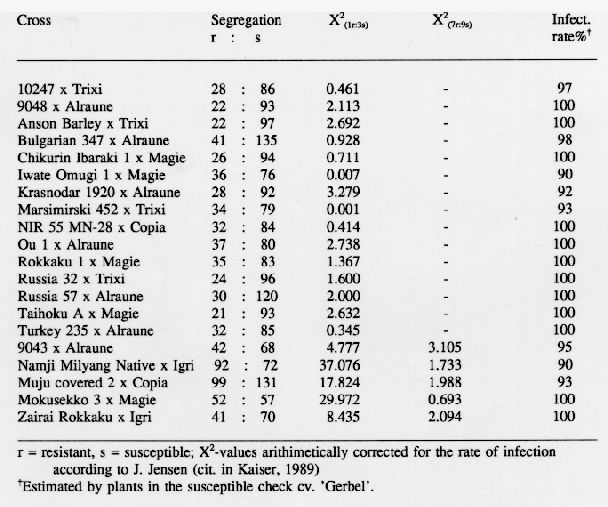

Due to a constant spread of the virus(es) and high yield losses frequently observed in the susceptible winter barley crop, barley yellow mosaic disease - now recognized to be caused by a complex of at least three viruses or virus strains, i.e. barley mild mosaic virus (BaMMV), barley yellow mosaic virus (BaYMV) and BaYMV-2 (Huth and Adams, 1990; Huth 1990) - is now one of the most important diseases of winter barley in Germany and other European countries. Because resistance of German cultivars is determined by an identical recessive gene ym4 (Friedt, 1985), which is not effective against BaYMV-2 (Huth,
BGN 70 Vol. 21
1989), numerous foreign germplasms were screened for resistance to BaMMV, BaYMV, and BaYMV-2. Furthermore, genetic analysis of resistance against BaMMV was carried out. This virus is mechanically transmissible efficiently (Friedt, 1983) and can be handled in the greenhouse under controlled conditions, therefore.
Several foreign gerrnplasms mainly derived from East Asia were screened for their reaction to BaMMV by mechanical spray-gun inoculation in the greenhouse (cf Friedt, 1983; Friedt et al., 1988), for BaMMV/BaYMV-reaction on an infested field in Bellnhausent Gilserberg (Northern Hesse) and for BaYMV-2-reaction in Schladen (Lower Saxony). Reactions were estimated by DAS-ELISA according to Casper and Meyer (1981). In order to get information about the mode of inheritance of BaMMV resistance, 19 foreign varieties carrying genes different from ym4 as well as 'Mokusekko 3', which carries a resistance gene allelic to ym4 (Götz, 1991), were crossed to susceptible German winter barley cultivars, like 'Trixi', 'Igri', and 'Alraune'. Furthermore, these varieties were intercrossed in order to analyze genetic diversity of BaMMV resistance. For this purpose F1 tests as well as F2 segregation analyses were carried out by mechanical inoculation in the greenhouse.
In the screening program different types of resistance to the yellow mosaic inducing viruses were observed (Table 1). Most of the varieties tested were resistant to BaMMV, BaYMV, and BaYMV-2. One variety was resistant to BaMMV only, while some germplasm showed resistance to BaYMV and BaYMV-2 but were susceptible to BaMMV. A fourth group reacted like resistant German cultivars, i.e. resistant to BaMMV and BaYMV but susceptible to BaYMV-2. The results obtained indicate that there is a complex situation not only with regard to the virus, but also regarding varietal reaction to the yellow mosaic inducing viruses.

F1 plants of all crosses between exotic germplasms and susceptible German cultivars were all susceptible to BaMMV. By F2 analyses it was shown that BaMMV resistance of most of the foreign resistant varieties tested is inherited by a single recessive gene. However, in some crosses an excess of resistant plants was observed in F2, which is an indication for the presence of two recessive genes. Agreement between observed segregation and theoretical expectation was assumed, if the chi-square value was lower than 3.841 (P=0.05) (cf. Table 2). Furthermore, F1 tests and F2 analyses of crosses between the foreign varieties mentioned in Table 2 revealed a high degree of genetic diversity concerning BaMMV resistance; allelic genes were found in 6 out of 59 cross-combinations tested in F2 only (Ordon, 1992).

The results of the studies on genetics of resistance to the yellow mosaic inducing viruses indicate that there are different genes of resistance available for broadening the basis of resistance to BaMMV. Unfortunately, the question whether the results obtained by mechanical inoculation also are valid for BaYMV and BaYMV-2 cannot be answered, yet. Both BaYMV and BaYMV-2 are not mechanically transmissible efficiently and therefore cannot be used for genetic analyses. However, genetic diversity concerning BaMMV-reaction was detected also in varieties which are resistant to all of the yellow mosaic inducing viruses, i.e. BaMMV, BaYMV, and BaYMV-2.
References:
Casper, R., and S. Meyer. 1981. Die Anwendung des ELISA-Verfahrens zum Nachweis pflanzenpathogener Viren. Nachrichtenbl. Deut. Pflanzenschutzd. 33:49-54.
Freidt, W. 1983. Mechanical transmission of soil-borne barley yellow mosaic virus. Phytopathol. Z. 106:16-22.
Freidt, W. 1985. Genetic studies of resistance to barley yellow mosaic virus of German winter barley cultivars. BGN 15:58-61.
Freidt, W., R. Kaiser, R. Götz, H. Umbach, and B. Foroughi-Wehr. 1988. Genetic basis of breeding for resistance to barley yellow mosaic virus. In: Cooper, J. I., and M. J. C. Asher. Developments in Applied Biology 2. Viruses with fungal vectors: 227-237.
Götz, R. 1991. Untersuchungen zur genetischen Diversität der Resistenz gegen den "Gelbmosaikvirus-Komplex" bei der Gerste (Hordeum vulgare L.). Diss. Univ. Giessen.
Huth, W. 1989. Ein weiterer Stamm des Barley yellow mosaic virus (BaYMV) gefunden. Nachrichtenbl Deut Pflanzenschutzd 41:6-7
Huth, W. 1990. The yellow mosaic inducing viruses of barley in Germany. Proc. 1st Symp. Intern. Working Group Plant Viruses with Fungal Vectors, Braunschweig, Germany, August 21-24. 1990: 113-115.
Huth, W., and M. J. Adams. 1990. Barley yellow mosaic virus (BaYMV) and BaYMV-M: two different viruses. Intervirology 31:38-42.
Kaiser, R. 1989. Lokalisierung des Reistenzgens gegen Gelbosakvirus (Barley Yellow Mosaic Virus) in deutschen Sorten der Wintergerste (Hordeum vulgare L.). Diss. Univ. Giessen.
Ordon, F. 1992. Genetische Analyse der Resistenz exotischer Gersten gegen bodenbürtige, mosaikinduzierende Viren. Diss. Univ. Giessen.